In the vibrant tapestry of nature’s palette, one bloom stands out with a delicate charm that captivates hearts and paints landscapes in shades of elegance – the Pink Tulip. These enchanting flowers, adorned in hues ranging from soft blush to deep magenta, symbolize grace, admiration, and affection. As spring unfolds its tender embrace, Pink Tulips emerge like a symphony of color, transforming gardens into a mesmerizing sea of pink.
With slender stems and gracefully cupped petals, Pink Tulips embody the poetry of nature in a simple yet profound manner. Their velvety textures and the gentle curvature of their blooms create an exquisite dance that catches the eye and holds it in rapt attention. Whether clustered together in a harmonious bouquet or standing alone as a solitary sentinel, Pink Tulips radiate an undeniable allure.
‘Angelique – Pink Tulips’
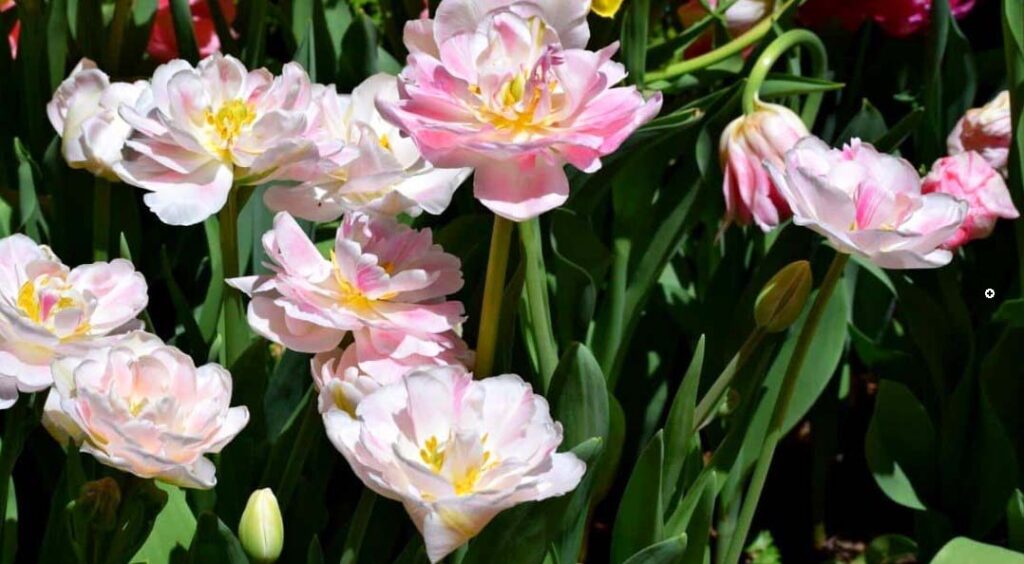
Pink Tulip ‘Angelique’ is a captivating and elegant perennial bulb that belongs to the Liliaceae family. It is a cultivar of the Tulipa genus and is renowned for its distinctive, soft pink, peony-like blooms. This plant type is a classic representation of the tulip family, known for its vibrant and enchanting flowers.
Geographic Origin
The Pink Tulip ‘Angelique’ originates from the Netherlands, a country renowned for its tulip production. Dutch tulip growers have meticulously bred and cultivated this particular variety, blending expertise with a passion for creating unique and stunning floral specimens.
Plant Size
The Angelique Tulip typically reaches a height of 12 to 18 inches (30 to 45 cm) and has a spread of 4 to 6 inches (10 to 15 cm). Its compact size makes it ideal for various garden settings, including flower beds, borders, and containers.
Sun Exposure
These tulips thrive in full sun to partial shade. They require at least 6 hours of sunlight daily for optimal growth and flowering. Planting them in well-draining soil ensures healthy development, while the exposure to sunlight encourages the tulips to showcase their delightful pink hues.
Plant Zone
Pink Tulip ‘Angelique’ is well-suited for planting in USDA hardiness zones 3 to 8. This encompasses a wide range of climates, making it adaptable to both colder and milder regions. The tulip bulbs can endure winter chill, providing a burst of color as a herald of spring in cooler zones, while flourishing in the moderate climates of zones 6 to 8.
‘Barcelona – Pink Tulips’
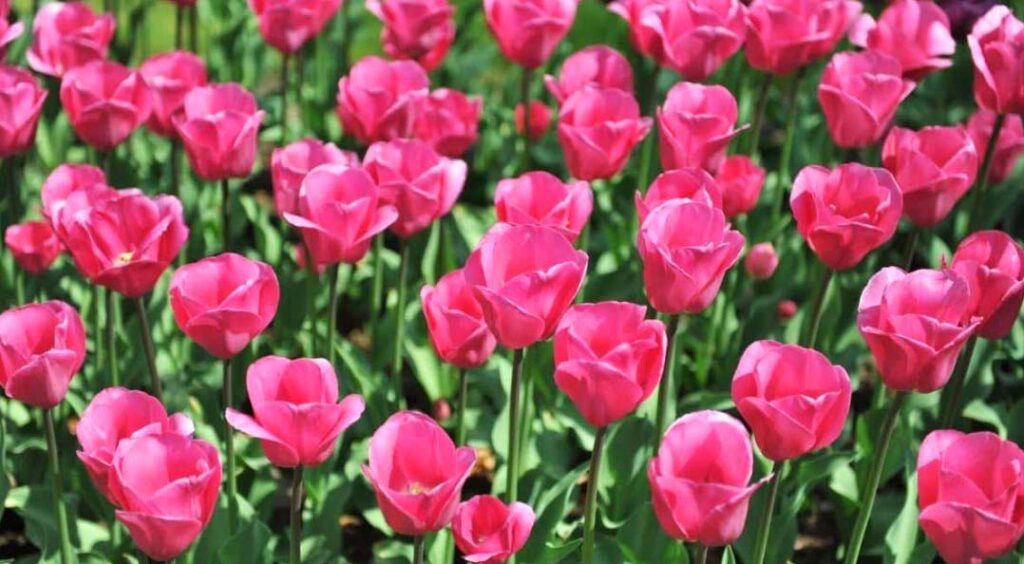
Plant Type
The Pink Tulip, known as “Barcelona,” belongs to the genus Tulipa, which is part of the lily family, Liliaceae. Tulips are herbaceous perennials with bulbous roots, producing showy and vibrant flowers.
Geographic Origin
The Pink Tulip – Barcelona is a cultivar derived from the Tulipa genus, which originated in Central Asia and the Middle East. However, Barcelona itself may have been developed and cultivated in various regions with suitable climates for tulip growth.
Plant Size
Pink Tulip – Barcelona typically grows to a moderate height, reaching around 12 to 18 inches (30 to 45 cm). The plant’s slender stems support the cup-shaped flowers, creating an elegant and graceful appearance.
Sun Exposure
These tulips thrive in full sun to partial shade. To encourage optimal blooming and vibrant coloration, it is recommended to plant them in locations where they receive at least 6 hours of direct sunlight per day. They can also tolerate some shade, making them versatile for different garden settings.
Plant Zone
Pink Tulip – Barcelona is well-suited for USDA plant hardiness zones 3 to 8. These zones encompass a broad range of climates, including both colder and milder regions. The plant can endure winter conditions typical of these zones, making it a popular choice for gardens in a variety of geographical areas.
‘Bella Blush – Pink Tulips’

Plant Type
The Pink Tulip, known as Bella Blush, belongs to the bulbous perennial plant type.
Geographic Origin
Bella Blush Pink Tulips originate from the Netherlands, where they are cultivated for their vibrant color and elegant beauty.
Plant Size
These tulips typically grow to a moderate height, reaching around 12 to 18 inches (30 to 45 cm) when fully mature.
Sun Exposure
Bella Blush Tulips thrive in full sun exposure, requiring at least 6 to 8 hours of direct sunlight each day for optimal growth and blooming.
Plant Zone
These tulips are well-suited for planting in USDA hardiness zones 3 to 8, making them adaptable to a wide range of climates and conditions.
‘China Town – Pink Tulips’
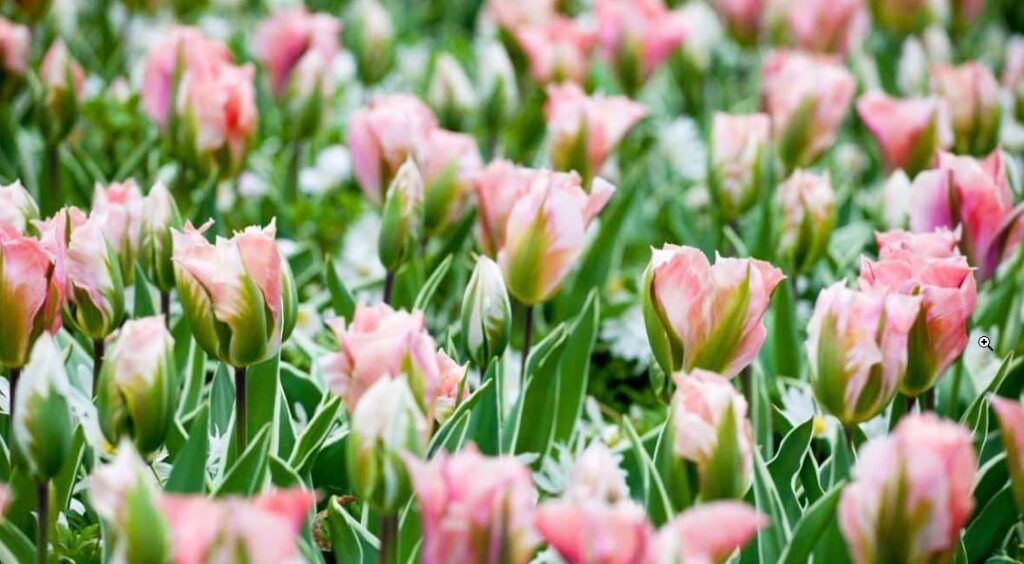
Plant Type
The Pink Tulip – China Town belongs to the tulip family, known for its vibrant and distinctive flowers.
Geographic Origin
Originating from China, the Pink Tulip – China Town carries a touch of the East in its unique characteristics.
Plant Size
This tulip variety typically grows to a moderate height, showcasing its elegant blooms without overwhelming garden spaces.
Sun Exposure
Thriving in full sun, the Pink Tulip – China Town prefers basking in bright sunlight to display its stunning pink petals to their fullest.
Plant Zone
Ideally suited for planting in zones compatible with its requirements, the Pink Tulip – China Town flourishes best when cultivated in zones that cater to its specific needs.
‘Cosmopolitan – Pink Tulips’
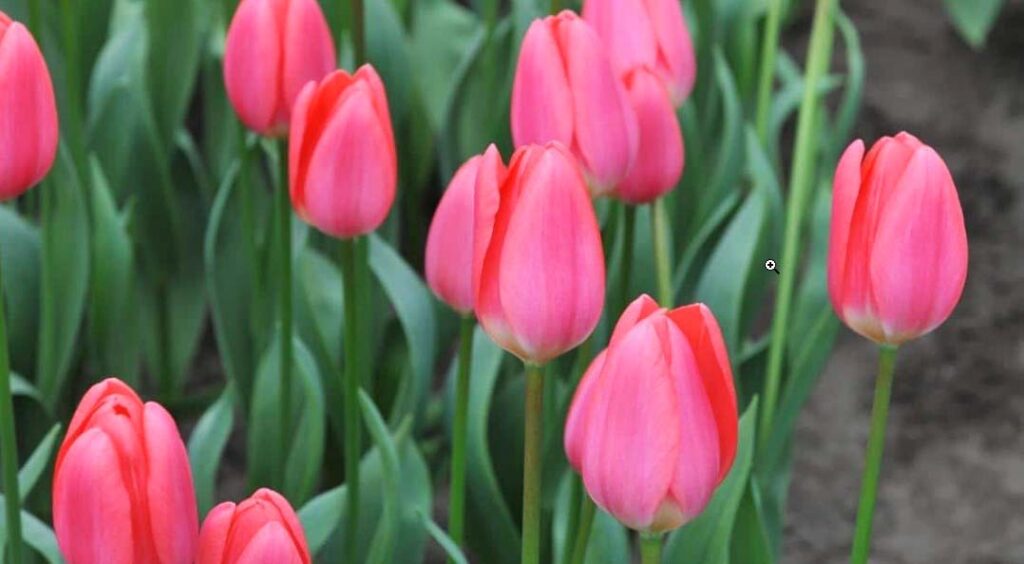
Plant Type
The Pink Tulip – Cosmopolitan is a bulbous perennial, adding a burst of vibrant color to gardens.
Geographic Origin
Hailing from the Netherlands, the Pink Tulip – Cosmopolitan thrives in temperate climates with well-drained soil.
Plant Size
This tulip variety stands at a moderate height, reaching around 12 to 18 inches, making it an ideal choice for borders and flower beds.
Sun Exposure
Thriving in full sun, the Pink Tulip – Cosmopolitan displays its radiant pink blooms best when planted in areas that receive ample sunlight.
Plant Zone
Ideal for USDA plant hardiness zones 3 to 8, this tulip variety is resilient to a range of climates, making it suitable for diverse gardening environments.
‘Dreamer – Pink Tulips’

Plant Type
The Pink Tulip-Dreamer belongs to the bulbous perennial category, characterized by its vibrant pink petals and elegant form.
Geographic Origin
Originally hailing from the Netherlands, the Pink Tulip – Dreamer thrives in climates with cool springs and moderate temperatures.
Plant Size
This tulip variety boasts a moderate size, reaching a height of approximately 12 to 18 inches when in full bloom, making it an ideal choice for gardens, borders, and containers.
Sun Exposure
Thriving under abundant sunlight, the Pink Tulip – Dreamer flourishes in areas with full to partial sun exposure, enhancing its vivid coloration and promoting healthy growth.
Plant Zone
Adaptable to various climates, this tulip is well-suited for planting in zones 3 to 8, ensuring a widespread appeal for gardeners in different regions.
‘Foxtrot – Pink Tulips’
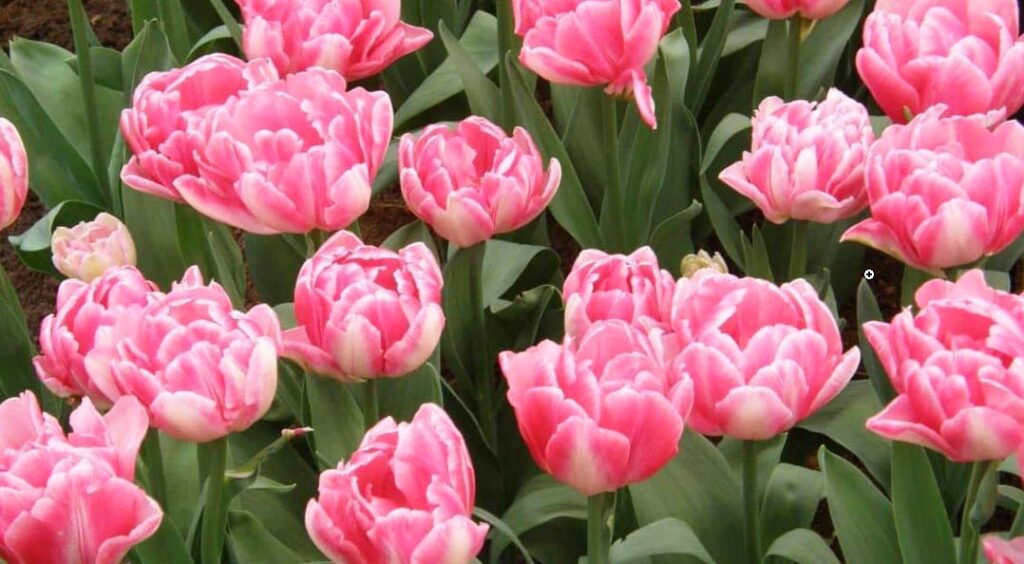
Geographic Origin
Originally hailing from the tulip-loving regions of the Netherlands, the Pink Tulip – Foxtrot brings a touch of Dutch elegance to gardens worldwide.
Plant Size
This tulip variety boasts a moderate size, reaching a height of approximately 14 to 18 inches (35 to 45 cm) when in full bloom, making it a charming addition to flower beds and borders.
Sun Exposure
Thriving under the spotlight, the Pink Tulip – Foxtrot craves sunlight. Plant it in a location where it can bask in full to partial sunlight for optimal growth and blooming.
Plant Zone
Adaptable to a variety of climates, the Pink Tulip – Foxtrot is suited for USDA plant hardiness zones 3 to 8. Whether your garden faces chilly winters or mild temperatures, this tulip variety can flourish with the right care.
‘Antoinette – Pink Tulips’

Plant Type
The Pink Tulip “Antoinette” belongs to the genus Tulipa, a perennial bulbous plant. Tulips are renowned for their vibrant and diverse colors, and Antoinette stands out with its enchanting pink hues.
Geographic Origin
The exact geographic origin of the Pink Tulip “Antoinette” may vary, as tulips have been cultivated and hybridized over the centuries. Tulips, in general, are native to regions stretching from Southern Europe to Central Asia. However, Antoinette’s specific hybridization and cultivation might involve influences from various geographic locations.
Plant Size
Antoinette tulips typically grow to a moderate height, making them suitable for various garden settings. The plant’s mature size can range from 12 to 18 inches (30 to 45 cm), creating an elegant display without overshadowing other garden companions.
Sun Exposure
Pink Tulip “Antoinette” thrives in full sun to partial shade. To ensure optimal growth and blooming, provide the plant with at least 6 hours of direct sunlight per day. A well-lit location enhances the vibrancy of its pink petals, creating a visually striking spectacle in gardens or containers.
Plant Zone
Antoinette tulips are well-suited for planting in USDA hardiness zones 3 to 8. These zones encompass a broad range of climates, from cold northern regions to milder southern areas. This adaptability makes Antoinette a versatile choice for gardeners in various geographical locations, provided they meet the plant’s sunlight and soil requirements.
‘Beauty trend – Pink Tulips’
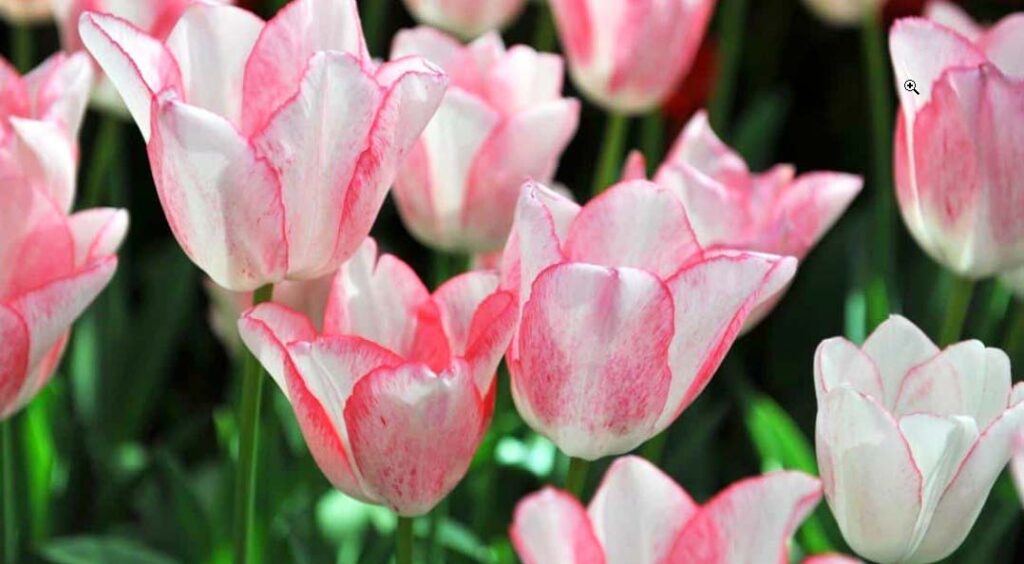
Geographic Origin
The Pink Tulip, Beautytrend, is native to the temperate regions of Central Asia, particularly the mountainous areas spanning parts of Turkey, Iran, and Afghanistan. Over time, tulips have been cultivated and hybridized, leading to the creation of numerous varieties with distinct colors and patterns. The Beautytrend cultivar showcases the enchanting beauty of pink hues.
Plant Size
The size of the Pink Tulip, Beauty trend, can vary, typically reaching a height of 10 to 16 inches (25 to 40 cm). The slender stems emerge from the bulb, adorned with lush green leaves. The modest height of this tulip variety makes it well-suited for garden borders, flower beds, or containers, where its captivating pink blooms can be prominently displayed.
Sun Exposure
Pink Tulips, including the Beautytrend variety, thrive in areas with full to partial sunlight. These plants require at least 6 hours of direct sunlight each day to produce robust and vibrant blooms. Adequate exposure to sunlight ensures proper photosynthesis, contributing to the tulip’s overall health and the development of its striking pink flowers.
Plant Zone
The Pink Tulip, Beautytrend, is well-suited for planting in USDA Hardiness Zones 3 to 8. These zones cover a range of climates, from cold winters to relatively mild temperatures, making the Beautytrend tulip adaptable to a variety of environments. Properly planting and caring for the bulbs in the recommended zones will ensure the tulips thrive and grace the garden with their captivating pink blossoms.
‘Big Brother’
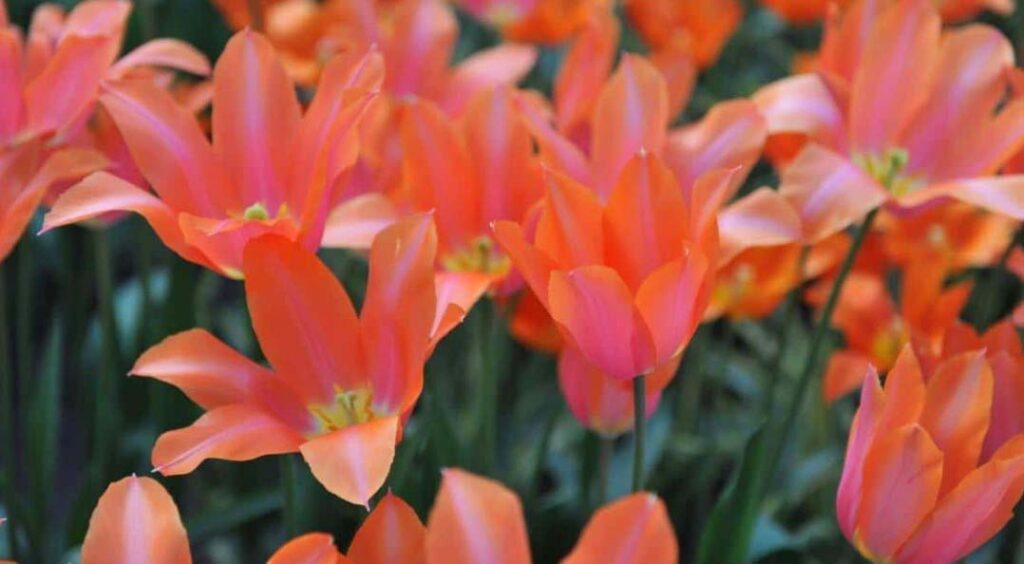
Plant Type
The Pink Tulip “Big Brother” belongs to the bulbous perennial category, showcasing its vibrant blooms year after year.
Geographic Origin
Native to the Netherlands, the Pink Tulip “Big Brother” brings a touch of Dutch charm to gardens worldwide.
Plant Size
This tulip variety stands tall and proud, reaching an impressive height of 18 to 24 inches (45 to 60 cm) when in full bloom.
Sun Exposure
Thriving in full sun, the Pink Tulip “Big Brother” enjoys basking in the warmth and requires at least six hours of sunlight daily for optimal growth.
Plant Zone
Adaptable to a variety of climates, this tulip is well-suited for planting in USDA hardiness zones 3 to 8, making it a versatile choice for different regions.
‘Cool Pink Lemonade’
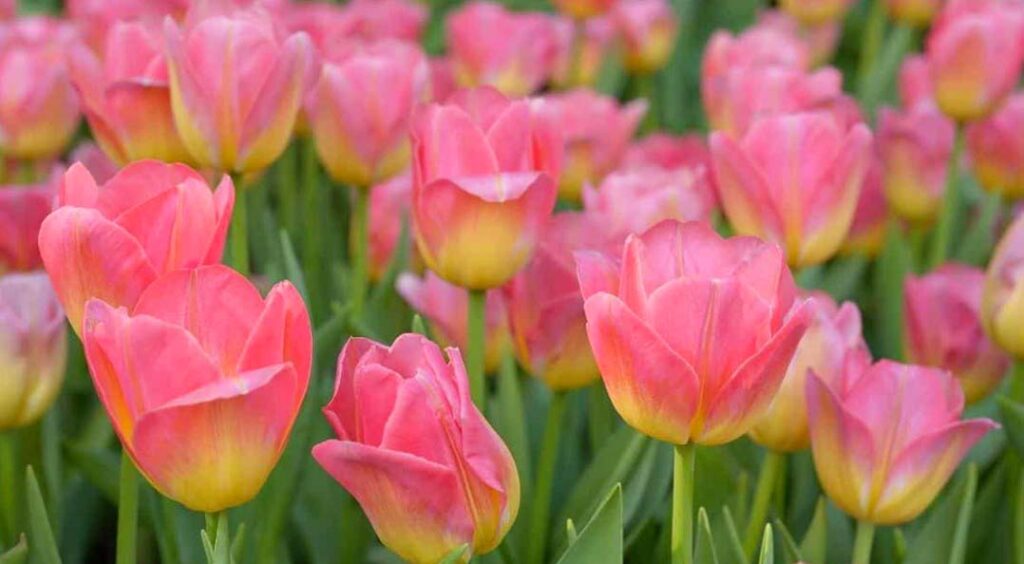
Plant Type
The Pink Tulip, known as “Cool Pink Lemonade,” belongs to the bulbous perennial category. Its vibrant pink hues make it a popular choice for gardens and landscapes.
Geographic Origin
This delightful tulip variety originates from the cool climates of the Netherlands, where it thrives in well-drained soil and moderate temperatures.
Plant Size
The Cool Pink Lemonade Tulip typically reaches a moderate height of 12 to 18 inches, making it an excellent addition to flower beds, borders, or containers.
Sun Exposure
Thriving in full sun to partial shade, this tulip variety enjoys bright sunlight but can also tolerate some shade, providing flexibility in garden placement.
Plant Zone
Well-suited for USDA plant hardiness zones 3 to 8, the Cool Pink Lemonade Tulip adapts to a range of climates, making it accessible and enjoyable for a wide audience of gardeners.
‘Fancy Frills’
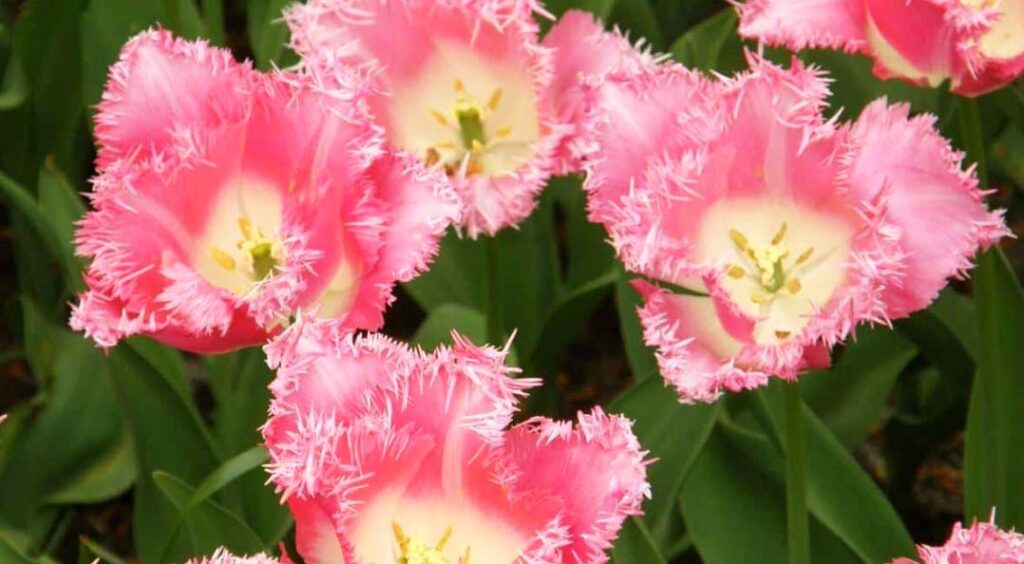
Plant Type
Pink Tulip – Fancy Frills falls under the category of bulbous perennials, displaying its exquisite blooms with each passing year.
Geographic Origin
Originating in the Netherlands, this striking tulip variant has spread its beauty to gardens worldwide, introducing a touch of Dutch charm to a variety of landscapes.
Plant Size
Boasting an elegant stature with an average height ranging from 14 to 18 inches, Pink Tulip – Fancy Frills proves to be a perfect choice for borders, containers, or as a vibrant component in floral arrangements.
Sun Exposure
Thriving under full sun conditions, this tulip type flourishes when bathed in direct sunlight, revealing its unique frilly petals in all their magnificent splendor.
Plant Zone
Pink Tulip – Fancy Frills is well-suited for USDA plant hardiness zones 3-8, showcasing its adaptability to a diverse range of climates. This makes it a versatile and robust addition to gardens in various regions.
‘Graceland’
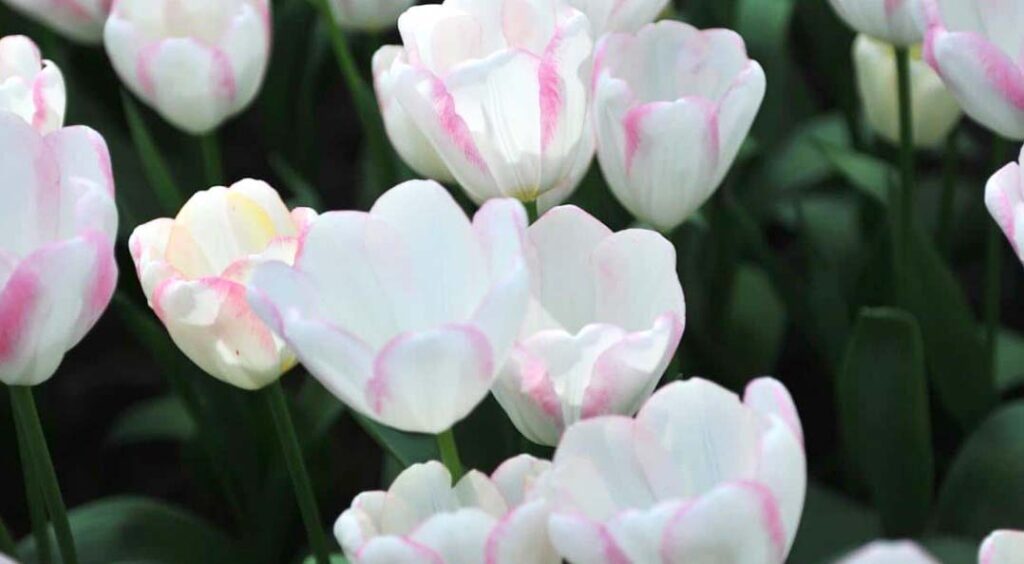
Plant Type
The Pink Tulip – Graceland belongs to the bulbous perennial category, known for its vibrant and enchanting pink flowers.
Geographic Origin
Originally hailing from the Netherlands, the Pink Tulip – Graceland has Dutch origins, thriving in regions with temperate climates.
Plant Size
This tulip variety boasts a moderate size, with stems reaching an average height of 12 to 18 inches, creating a delightful display in gardens and landscapes.
Sun Exposure
Thriving in full sun to partial shade, the Pink Tulip – Graceland prefers locations with ample sunlight to showcase its striking pink blooms.
Plant Zone
Adaptable to various climates, this tulip is well-suited for planting in USDA hardiness zones 3 to 8, ensuring its resilience and beauty across a range of environments.
FAQ
What do pink tulips symbolize?
Pink tulips symbolize affection, care, and happiness. These vibrant flowers convey a message of love and appreciation. They are often associated with feelings of warmth and joy, making them a perfect choice for expressing admiration or gratitude.
The color pink itself represents sweetness and affection, making pink tulips a delightful gift to brighten someone’s day and communicate positive emotions.
Are pink tulips romantic?
Pink tulips evoke romance with their soft petals and delicate hue. Their gentle color symbolizes affection and admiration. The vibrant pink shade is associated with love and tenderness, making pink tulips a romantic choice. These flowers convey a message of sweetness and appreciation, perfect for expressing heartfelt emotions.
Whether gifted in a bouquet or presented individually, pink tulips effortlessly capture the essence of romance. Making them a charming and thoughtful gesture for expressing love and admiration.
What is the rarest tulip color?
The rarest tulip color is black. Black tulips are exceptionally uncommon in nature, making them highly sought after by tulip enthusiasts. These distinctive flowers are the result of a fascinating interplay of genetics that leads to the deep, velvety hue.
While other tulip colors are more common, the rarity of black tulips adds an element of intrigue and allure to these unique blooms. Gardening enthusiasts and collectors often cherish black tulips for their unusual and captivating appearance, making them a coveted and prized addition to any garden.
What is the rarest type of tulip?
The rarest type of tulip is the Semper Augustus. Its petals are white with red flames, creating a captivating pattern. This tulip gained fame during the Dutch Tulip Mania in the 17th century, fetching astronomical prices.
Today, it’s extremely scarce, with only a few bulbs remaining. Its rarity is due to a virus that affects the tulip’s colors, making it challenging to cultivate. Collectors value the Semper Augustus for its historical significance and exquisite beauty, making it a symbol of the tulip’s intriguing and elusive allure.
Conclusion
“Pink Tulips” stand as vibrant ambassadors of nature’s beauty. Their delicate petals, painted in hues of pink, create a mesmerizing spectacle that captivates the beholder. These flowers not only please the eye but also symbolize grace and elegance. The subtle fragrance they emit adds to the overall sensory experience, leaving a lasting impression on anyone fortunate enough to encounter them.
Through their vivid colors and soft demeanor, pink tulips communicate a sense of joy and optimism, brightening the surroundings they inhabit. As nature’s artists, these blooms paint landscapes with hues of positivity, making them an enchanting presence in gardens and floral arrangements alike.






